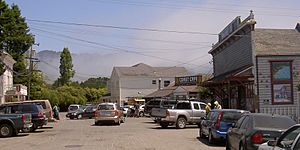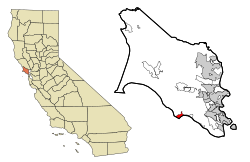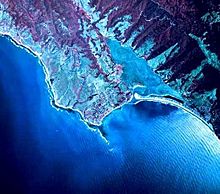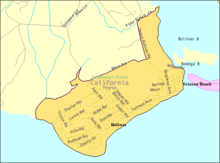Bolinas, California facts for kids
Quick facts for kids
Bolinas
|
|
|---|---|

Street scene in Bolinas, 2009
|
|

Location in Marin County and the state of California
|
|
| Country | |
| State | |
| County | Marin |
| Government | |
| • Type | Unincorporated |
| Area | |
| • Total | 5.83 sq mi (15.09 km2) |
| • Land | 5.83 sq mi (15.09 km2) |
| • Water | 0.00 sq mi (0.00 km2) 0% |
| Elevation | 36 ft (11 m) |
| Population
(2020)
|
|
| • Total | 1,483 |
| • Density | 254.55/sq mi (98.27/km2) |
| Time zone | UTC-8 (Pacific) |
| • Summer (DST) | UTC-7 (PDT) |
| ZIP code |
94924
|
| Area codes | 415/628 |
| FIPS code | 06-07316 |
| GNIS feature IDs | 277476, 2407875 |
Bolinas is a small coastal town in Marin County, California, United States. It's not officially a city, but a "census-designated place." This means it's a community that the government counts for population, but it doesn't have its own city government. In 2020, about 1,483 people lived there.
Bolinas is located right on the California coast. It's about 13 miles (21 km) northwest of San Francisco. The town is known for its quiet, private feel. People who live there often remove road signs that point the way into town. This makes it a bit of a hidden gem!
Contents
History
Long ago, before Europeans arrived in California, the Coast Miwok people lived in the Bolinas area. They might have called the place "Bali-N."
Bolinas and nearby Stinson Beach were once part of a large Mexican land grant called Rancho Las Baulines. This land was given to Gregorio Briones in 1846.
The first post office in Bolinas opened in 1863. It closed in 2023, making the town feel even more isolated. However, local residents have asked for it to reopen.
In 1927, a large area of land called the Big Mesa was divided into many small lots. Many of these lots were sold cheaply as a way to promote the San Francisco Bulletin newspaper. Over time, some parts of this mesa have eroded into the sea.
The beaches of Bolinas were badly affected by an oil spill in 1971. The community worked together to clean up the crude oil.
The Bolinas Museum started in 1983. It has five galleries that show modern art, historical information, and art from local artists. The museum also hosts events for both locals and visitors.
Geography
Bolinas is located about 36 feet (11 meters) above sea level. It is surrounded by beautiful natural features. To the northeast, you'll find Bolinas Lagoon and Kent Island. To the south, there's Bolinas Bay and Duxbury Point. The Pacific Ocean is to the southwest, and Point Reyes National Seashore is to the northwest.
The town covers about 5.8 square miles (15.09 square kilometers) of land. Some old names for Bolinas include "Ballenas" and "Baulenas."
Bolinas' main area is along Wharf Road, which leads to Bolinas Lagoon. Many of the buildings downtown were built between 1850 and 1920. Brighton Avenue connects downtown to Brighton Beach. The town also has two main mesa areas: the Little Mesa and the Big Mesa (also called the Gridded Mesa). Agate Beach is at the western end of the Big Mesa.
Even though Bolinas is only about 2 miles (3.2 km) from State Route 1, it's not very easy to reach by car. It takes about an hour to drive to downtown San Francisco.
Bolinas is located west of the San Andreas Fault. This famous fault line runs along Bolinas Lagoon. Bolinas and the Point Reyes peninsula are on the Pacific Plate. This plate moves north about 1 inch (2.5 cm) each year compared to Stinson Beach.
Point Reyes National Seashore is a beautiful park that borders Bolinas to the northwest. The Duxbury Reef State Marine Conservation Area protects the ocean wildlife along Bolinas' western shoreline.
Climate
Bolinas has warm and dry summers. The average temperature in summer months can be above 77.1°F (25°C). This type of weather is called a "warm-summer Mediterranean climate." Like many places on the California coast, summer afternoons are often cool and windy. Sometimes, it can even be foggy as winds blow in from the ocean.
Bolinas gets more rain than other coastal cities in the San Francisco Bay Area. It receives about 40.7 inches (1034.70 mm) of rain each year.
| Climate data for Bolinas, California | |||||||||||||
|---|---|---|---|---|---|---|---|---|---|---|---|---|---|
| Month | Jan | Feb | Mar | Apr | May | Jun | Jul | Aug | Sep | Oct | Nov | Dec | Year |
| Mean daily maximum °F (°C) | 55.2 (12.9) |
59.6 (15.3) |
63.0 (17.2) |
66.1 (18.9) |
69.8 (21.0) |
74.1 (23.4) |
76.7 (24.8) |
77.1 (25.1) |
77.0 (25.0) |
72.1 (22.3) |
62.6 (17.0) |
55.3 (12.9) |
67.4 (19.7) |
| Daily mean °F (°C) | 48.8 (9.3) |
52.2 (11.2) |
54.5 (12.5) |
56.8 (13.8) |
55.8 (13.2) |
59.9 (15.5) |
65.4 (18.6) |
65.8 (18.8) |
65.4 (18.6) |
61.7 (16.5) |
54.8 (12.7) |
49.1 (9.5) |
57.5 (14.2) |
| Mean daily minimum °F (°C) | 42.3 (5.7) |
44.7 (7.1) |
45.9 (7.7) |
47.4 (8.6) |
50.0 (10.0) |
52.7 (11.5) |
54.0 (12.2) |
54.4 (12.4) |
53.8 (12.1) |
51.3 (10.7) |
47.0 (8.3) |
42.9 (6.1) |
48.9 (9.4) |
| Average precipitation inches (mm) | 7.7 (200) |
7.8 (200) |
5.5 (140) |
2.2 (56) |
1.3 (33) |
0.3 (7.6) |
0 (0) |
0.1 (2.5) |
0.3 (7.6) |
1.9 (48) |
5.3 (130) |
8.3 (210) |
40.7 (1,034.7) |
| Source: Bestplaces.net | |||||||||||||
Demographics
| Historical population | |||
|---|---|---|---|
| Census | Pop. | %± | |
| 2000 | 1,246 | — | |
| 2010 | 1,620 | 30.0% | |
| 2020 | 1,483 | −8.5% | |
| U.S. Decennial Census | |||
In 2010, the population of Bolinas was 1,620 people. Most residents (86.8%) were White. About 16% of the people identified as Hispanic or Latino.
The town had 698 households. Many families lived there, with about 20.6% of households having children under 18. The average household had about 2 people. The median age of residents was 49.3 years old.
In 2000, there were 1,246 people in Bolinas. The population density was about 900 people per square mile (347 per square kilometer). The racial makeup was mostly non-Hispanic White (77.7%). About 16% of the population was Hispanic or Latino.
Education
Bolinas is part of a few school districts. Younger students (kindergarten to 2nd grade) go to Stinson Beach School. Older elementary students (grades 3-8) attend Bolinas School. For high school, students usually go to Tamalpais High School in Mill Valley.
In 1951, a magazine called Ford Times described Bolinas as a "Tom Sawyer Town." They said it was a great place for kids to grow up, with lots of opportunities for fishing, swimming, baseball, and dreaming in the sun.
Regional Recreation and Marine Protected Areas
Bolinas offers many fun outdoor activities. There's a public beach near downtown. You can also visit Agate Beach, which is a county park. It has amazing tide pools that are protected as part of the Gulf of the Farallones National Marine Sanctuary. This means the sea creatures there are safe.
The town is also home to the Marin-Bolinas Botanical Gardens. It's right next to the Point Reyes National Seashore to the north. You can hike to Alamere Falls, which is a rare waterfall that flows right onto the beach! It's one of only two such waterfalls in the continental U.S.
Off the coast of Bolinas is the Duxbury Reef State Marine Conservation Area. This area is like an underwater park. It helps protect ocean wildlife and marine ecosystems, keeping the ocean healthy.
In Popular Culture
Bolinas and its reputation for being a bit hidden were featured in the 1981 novel Ecotopia Emerging by Ernest Callenbach.
The 1999 movie Wildflowers, starring Daryl Hannah, was partly filmed in Bolinas.
You might even find a piece of Bolinas in Return of the Jedi! Stickers that say "Radio Free Bolinas" were secretly placed on some of the Y-wing pilot helmets in the movie. Radio Free Bolinas was a pirate radio station that started in 1978. The prop makers for the movie likely listened to this station while working on the helmets.
Notable People
See also
 In Spanish: Bolinas (California) para niños
In Spanish: Bolinas (California) para niños








